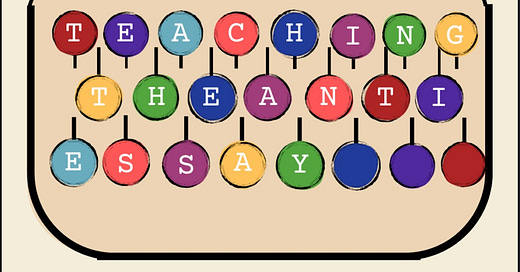[Mock-up book cover by Louis Basso].
For any English teacher with overcrowded classrooms in California or Texas (instructing five class sections - or more - every day), any English major currently enrolled in an undergraduate program (or someone going through their Post-bac teaching practicum), or anyone guiding student writers to meaningfully engage with the English language, I can only say that I wish there were more of you.
But there aren’t. And the downtrend is alarming.
The 2021 cancelled Netflix show “The Chair” (starring Sandra Oh) set at the fictional liberal arts college Pembroke, zoned in on a failing English Department and its diminishing enrollment, and an aging faculty that was increasingly out-of-touch with the modern student.
Of all students currently enrolled in college, only 2.8% are English majors.
Since 2020, SIXTY-FOUR (64) liberal arts colleges have shuttered or announced closures.
Liberal arts schools are going the way of the American shopping mall — only about 1,000 large-footprint malls remain open. Some predict only 150 shopping centers will endure by 2032.
What has happened to the aspirational English teacher? Where will they teach? What will they teach?
And there are fewer than 25,000 English professors in America. 170 million workers in this country, but only 25,000 English professors. 1 million ESL teachers, but only about 100,000 (all told) classroom ELA teachers.
On the bright side, there are 32 million bloggers in the US. People are writing more than ever before, with more platforms to get their voice out.
Almost none of them, however, post 5 paragraph essays.
Almost none of them post about the failure of the American Dream in The Great Gatsby, or the significance of the green light at the end of Daisy’s dock.
I started teaching HS English in 1994. I student-taught grades 8 - 12. I had 5 unique preps each day in Ashland, MA. I took over my cooperating teacher’s classes almost on day one (and I was most definitely not ready to do so). Before that, I did my field-work at Newton North High School (outside Boston), where I occasionally gave writing feedback to students who couldn’t read my edit notes (after I had marked them up, their essays looked like old prescription pads with drug names and dosages utterly indecipherable even to veteran primary care physicians).
Fast forward thirty one years: I started writing my book Teaching The Anti Essay: 18 Creative Nonfiction Essay Prompts for The English Classroom. The “big idea” behind it was that I’d export my “anti-essay” philosophy to other English teachers and college writing professors who were experiencing the hangover brought on by student apathy, and the creative wasteland technology had wrought.
I’ve found 18 ways “into the essay,” yes. 18 ways you may not have thought of. More than that, they’re 18 ways into the self. If English is “the stuff of life” (as my now retired friend Nelson DaSilva once said), then why do we get acid reflux when students use personal pronouns in an essay?
Yesterday, I had a writing conference with a sophomore named Lily who came to grade her seventh full length paper of this academic year (it was the close of semester one).
At the end of the meeting she said to me, genuinely, truly, without a scintilla of grade-grubbing or obsequiousness —
“Please tell me that I’ll get the chance to write essays like this one next year. Will I?”
____________________________________________________________________________
Teaching The Anti Essay: 18 Creative Nonfiction Essay Prompts for The English Classroom will be released in the late summer of 2025 by Taylor & Francis.
[Angela Chiang’s mock-up book cover].






Can’t wait to get this book when it comes out!